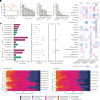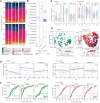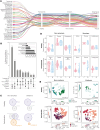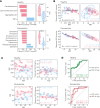Meta-analysis of oral microbiome reveals sex-based diversity in biofilms during periodontitis
- PMID: 39253976
- PMCID: PMC11385077
- DOI: 10.1172/jci.insight.171311
Meta-analysis of oral microbiome reveals sex-based diversity in biofilms during periodontitis
Abstract
Sex is an often overlooked, yet compulsory, biological variable when performing biomedical research. Periodontitis is a common yet progressively debilitating chronic inflammatory disorder affecting the tissues supporting teeth that ultimately leads to tooth loss if left untreated. The incidence of periodontitis is sex biased, with increased prevalence in males compared with females but with unknown etiology. We performed a sex-specific meta-analysis using publicly available oral microbiome data from different sampling sites of patients with periodontitis and periodontally healthy controls; sex balance was established for each periodontal health condition. Our results show sex-based diversity in oral biofilms of individuals with periodontitis but not in their saliva, with increased abundance of several periodontal pathogens in subgingival plaques from females compared with males. We devised a quantitative measure, uniquely defined as the Microsexome Index (MSI), which indicates that sexual dimorphism in subgingival bacterial composition is a distinct feature of reduced microbial diversity during periodontitis but not under healthy conditions. In addition, we found that smoking exacerbates microsexome diversity in supragingival biofilms, particularly during periodontitis. Taken together, we provide insights regarding sex-based diversity in periodontitis, a disease with multiorgan associations, and provide the rationale for further mechanistic, diagnostic, and therapeutic studies.
Keywords: Epidemiology; Inflammation; Microbiology.
Figures




Similar articles
-
Quantifying periodontitis-associated oral dysbiosis in tongue and saliva microbiomes-An integrated data analysis.J Periodontol. 2025 Jan;96(1):55-66. doi: 10.1002/JPER.24-0120. Epub 2024 Jul 15. J Periodontol. 2025. PMID: 39007741 Free PMC article.
-
Manipulation of Saliva-Derived Microcosm Biofilms To Resemble Dysbiotic Subgingival Microbiota.Appl Environ Microbiol. 2021 Jan 15;87(3):e02371-20. doi: 10.1128/AEM.02371-20. Print 2021 Jan 15. Appl Environ Microbiol. 2021. PMID: 33158898 Free PMC article.
-
Relative abundance of total subgingival plaque-specific bacteria in salivary microbiota reflects the overall periodontal condition in patients with periodontitis.PLoS One. 2017 Apr 3;12(4):e0174782. doi: 10.1371/journal.pone.0174782. eCollection 2017. PLoS One. 2017. PMID: 28369125 Free PMC article.
-
The subgingival periodontal microbiota of the aging mouth.Periodontol 2000. 2016 Oct;72(1):30-53. doi: 10.1111/prd.12136. Periodontol 2000. 2016. PMID: 27501490 Free PMC article. Review.
-
Influence of periodontal surgery on the subgingival microbiome-A systematic review and meta-analysis.J Periodontal Res. 2023 Apr;58(2):308-324. doi: 10.1111/jre.13092. Epub 2023 Jan 4. J Periodontal Res. 2023. PMID: 36597817
Cited by
-
Pathogenic mechanisms and potential applications of extracellular vesicles from periodontal pathogens in periodontitis.Front Immunol. 2024 Dec 20;15:1513983. doi: 10.3389/fimmu.2024.1513983. eCollection 2024. Front Immunol. 2024. PMID: 39759521 Free PMC article. Review.
-
Meta-Analysis of 16S rRNA Sequencing Reveals Altered Fecal but Not Vaginal Microbial Composition and Function in Women with Endometriosis.Medicina (Kaunas). 2025 May 14;61(5):888. doi: 10.3390/medicina61050888. Medicina (Kaunas). 2025. PMID: 40428846 Free PMC article.
-
Engineered Tissue Models to Decode Host-Microbiota Interactions.Adv Sci (Weinh). 2025 Jun;12(23):e2417687. doi: 10.1002/advs.202417687. Epub 2025 May 14. Adv Sci (Weinh). 2025. PMID: 40364768 Free PMC article. Review.
-
Identification of key genes in periodontitis.Front Genet. 2025 Mar 19;16:1579848. doi: 10.3389/fgene.2025.1579848. eCollection 2025. Front Genet. 2025. PMID: 40176796 Free PMC article.
-
Sex bias in tumor immunity: insights from immune cells.Theranostics. 2025 Mar 31;15(11):5045-5072. doi: 10.7150/thno.106465. eCollection 2025. Theranostics. 2025. PMID: 40303343 Free PMC article. Review.
References
Publication types
MeSH terms
Grants and funding
LinkOut - more resources
Full Text Sources

